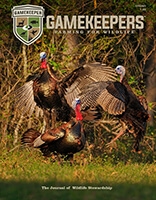Easing cautiously through the grass and shrubs lining the drainage below a pond on my property, I hunkered down low for the final approach. At a specific time I had pre-arranged with my hunting buddy, I poked my head up over the dam. With a quick hand signal to alert him, I took five fast steps forward.
The sweet, thundering sound of flushing wings greeted me, along with the awesome sight of nearly a dozen ducks erupting from the water. Taking aim at a bright-colored woodie, I squeezed off a quick shot, then pulled the side-by-side barrel ahead of a mallard drake and slapped the second trigger. Two ducks lay still on the water.
But that was only half of it. My partner was in the perfect spot—on a brushy corner of the pond next to a small island—and took a greenhead cleanly, then missed a second one as the birds sped past him.
Another successful pond hunt, one that took place quickly and allowed us plenty of time to hit another nearby pond and fill our limits.
If you aren’t fortunate enough to be a member of an exclusive duck hunting club with carefully managed waters, permanent blinds, and vast bays and sounds to visit, take heart. There are plenty of overlooked duck habitats that anyone can hunt by just poring over aerial photos and topo maps and knocking on a few doors. If you’re a property owner, you might even have these small waters on your land or have places where you can create them for future hunts. It only takes a small amount of water to attract ducks. The trick is—as realtors say—location, location, location.
Sure, I’ll take any invitation to hunt one of those expansive waterfowl paradises that wealthy people have access to. But some of my favorite spots for both early- and late-season hunting are small ponds, potholes, river overflows, and beaver dam puddles. Any small depressions with just a quarter acre or more of water, whether year-round or seasonal, can hold a bounty of ducks and offer some great, neglected hunting opportunities.
U.S. Fish & Wildlife Service surveys show there’s a pond within ten miles of 80 percent of the U.S. population. Simply talking with farmers and mail carriers or emailing the local game warden or regional wildlife biologist can often reveal good prospects.
In addition to ponds, check out low spots adjacent to rivers that overflow during heavy rain or snows and hold water for a while. I’ve had superb hunting on areas where the Shenandoah River in Virginia spilled over into farm fields during heavy rains. And don’t forget to check out places where beavers have dammed up small creeks.
The secret for success is locating spots currently being used by birds. And the way to do that is to do lots of planning and scouting ahead of the hunt.
Pond duck hunting can be broken down into two time frames—early season and late. Here’s a look at each.

Gerald Almy
Early Season
In the early season, pressure isn’t usually a major factor. For hunts in September and October, look for the birds on ponds near crop fields or other food sources such as aquatic plants or acorns. Cover in the form of shoreline trees or flooded timber can also attract ducks.
These ponds will typically produce good shooting year after year. Keep a list of them—and get several pinpointed so if one is barren of birds, you can head to another one. Watching for flying flocks from high, open spots at first light and just before dusk can also be productive.
Consulting satellite imagery and aerial photography is a good way to get started. But for early-season hunts, the best way to succeed is often to simply do lots of in-the-field preseason scouting. You can simply drive back-country roads and search, while stopping occasionally to consult your maps.
Sometimes I combine this scouting for potential early-season duck spots with fishing, since fall is a great time for pond bass and panfish action. Flush the ducks, then break out the fly rod or spinning outfit.
By flushing off birds and staying there until you catch a few fish, you can see whether the ducks are likely to return if you set up in a makeshift blind along shore on a later hunting outing. If the birds don’t return or circle like they were going to while you’re fishing, that pond would probably lend itself better to jump shooting. With the knowledge of several ponds holding ducks, you can hop from one to the next in early season, often filling a limit quickly if the ponds haven’t been pressured.
Late Season
During winter, many small potential duck spots are unproductive because they are frozen over. That’s a tactical advantage in a way, because the ones that are not solid ice will attract ducks that are in the area. These are often spring-fed and can be magnets for traveling waterfowl at this time.
Others appeal to birds because they are more secluded and don’t receive much, if any, hunting pressure. These often require a hike to reach.
Most late-season birds have been exposed to months of hunting pressure on large impoundments, bays, and sounds. There’s nothing they want more than a secluded pond or pothole to hide out on. That’s the type of spot on which to concentrate.
And think small. The smaller the water, the less likely other hunters will think it could hold ducks. If you have land with ponds, you may not even have to drive to your hunting location. If you don’t, think about good locations to create them.
The more of these tiny bodies of water you locate, the better the chances one will hold ducks on any given day. If they require a long walk to get to, the odds are even better for finding a motherlode of birds.

Linda Arndt
Strategies
Two strategies work best for hunting these micro duck waters—jump shooting or waiting for the birds to come to you. Here’s a look at both techniques.
Jump Shooting—This is one of the most exciting tactics you can use for pond ducks, since it entails stalking and fast-paced shooting. If possible, scout from a distance with binoculars and try to see if birds are present before you approach. If so, pinpoint how many, where they are located, and what species, if possible. With complicated duck regulations in many states, you can’t just flush birds and start shooting. Species identification before approaching or after the birds are airborne is vital for a law-abiding hunt.
After you’ve scoped out where the birds are holding—or know from previous scouting trips the spots where they usually hang out—check out the topography to see where ditches, hills, or brushy vegetation will allow the closest stalk.
Ideally, the goal should be to get within 30 yards or less of the birds for good jump shooting. Ten or 20 yards is better still. As you stalk, keep a low profile and move silently, trying to stay behind cover as you approach.
A pair of hunters can stalk together if you know the location of the birds. Set a time when you both move up and flush the birds simultaneously. Alternately, have one hunter jump them and the other hunter hide in cover where the birds usually fly when flushed. Always be aware of where your partner is, though, for safety reasons. Don’t shoot anywhere close to their direction.
When a flock of ducks suddenly rises up, it can seem chaotic. Force yourself to select one target. Once you shoot and connect with that bird, then pick out another duck if they are still within range. Always try when possible to pick out male ducks. One of my most exciting flushes ever saw over three dozen wood ducks and a couple mallards erupt from a half-acre pond. Talk about awesome outdoor experiences!
A good retriever definitely helps to collect the birds and share the hunt with you. If you don’t have one, bring waders, a small boat, or a rod-and-reel with a treble-hook lure to retrieve the ducks you shoot.

Jim Cumming
Waiting Them Out
A second major strategy that works for ponds involves waiting for the birds to come to you. Either get in before daylight and await the ducks’ return, or flush them off without shooting and wait for them to come back. With either approach, the technique is basically the same. What you’re relying on is the appeal of that resting area to bring in the birds.
If ducks are already on the water, try to flush them subtly, in small groups. You don’t want to totally scare them—just make them a bit nervous. That way, they’ll return in small flocks that offer extended shooting.
You can set out a few decoys, and sometimes that makes the hunt more exciting. But I have often simply waited by the water in some brush or a makeshift blind and had birds pour back in anywhere from a few minutes to an hour or more later. If you’re good with a call, that can also help.
When you set up on a pond before dawn, ducks will usually come pitching in at first light. If you flush birds off during the day, expect to wait 15 to as long as 60 minutes before they return. Of course, there is no guarantee they will come back. That’s the gamble you take with this tactic.
When the ducks do come back to these small bodies of water, they’ll circle warily at first. But soon, you’ll hear that magnificent sound of wings whistling through the cold autumn air, then watch—mesmerized—as the birds drop down into shotgun range. It’s one of the most rewarding of all waterfowling experiences.
-
Join our weekly newsletter or subscribe to Gamekeepers Magazine.
Your source for information, equipment, know-how, deals and discounts to help you get the most from every hard-earned moment in the field.









